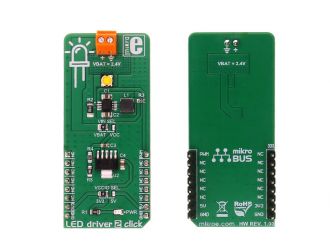
We strongly encourage users to use Package manager for sharing their code on Libstock website, because it boosts your efficiency and leaves the end user with no room for error. [more info]

Rating:
Author: MIKROE
Last Updated: 2019-03-15
Package Version: 1.0.0.1
mikroSDK Library: 1.0.0.0
Category: LED Drivers
Downloaded: 3622 times
Not followed.
License: MIT license
LED driver 2 click carries the MCP1643 - LED constant current regulator, made by Microchip. It is a compact, high-efficiency, fixed frequency, synchronous step-up converter, optimized to drive one LED with the constant current. It can be powered by a two-cell alkaline/NiMH/NiCd battery (2.4V), or via the mikroBUSâ„¢ power supply pins.
Do you want to subscribe in order to receive notifications regarding "LED Driver 2 click" changes.
Do you want to unsubscribe in order to stop receiving notifications regarding "LED Driver 2 click" changes.
Do you want to report abuse regarding "LED Driver 2 click".

Library Description
The library covers all the necessary functions to control LED Driver 2 click board. LED Driver 2 click communicates with the target board via PWM module. This library contains drivers for PWM function:
initialization, for sets duty ratio, starts and stops PWM module.
Key functions:
Examples description
The application is composed of three sections:
void applicationTask()
{
mikrobus_logWrite( " Light Intensity Rising ", _LOG_LINE );
Delay_1sec();
for ( dutyCycle = 5; dutyCycle < 255; dutyCycle += 25 )
{
leddriver2_pwmSetDuty( dutyCycle );
mikrobus_logWrite( " >", _LOG_TEXT );
Delay_100ms();
}
mikrobus_logWrite( ">", _LOG_LINE );
mikrobus_logWrite( "-------------------------", _LOG_LINE );
mikrobus_logWrite( " Light Intensity Falling ", _LOG_LINE );
Delay_1sec();
for ( dutyCycle = 255; dutyCycle > 5; dutyCycle -= 25 )
{
leddriver2_pwmSetDuty( dutyCycle );
mikrobus_logWrite( " <", _LOG_TEXT );
Delay_100ms();
}
mikrobus_logWrite( "<", _LOG_LINE );
mikrobus_logWrite( "-------------------------", _LOG_LINE );
Delay_1sec();
}
Additional Functions :
Other mikroE Libraries used in the example:
PWMUARTAdditional notes and informations
Depending on the development board you are using, you may need USB UART click, USB UART 2 click or RS232 click to connect to your PC, for development systems with no UART to USB interface available on the board. The terminal available in all MikroElektronika compilers, or any other terminal application of your choice, can be used to read the message